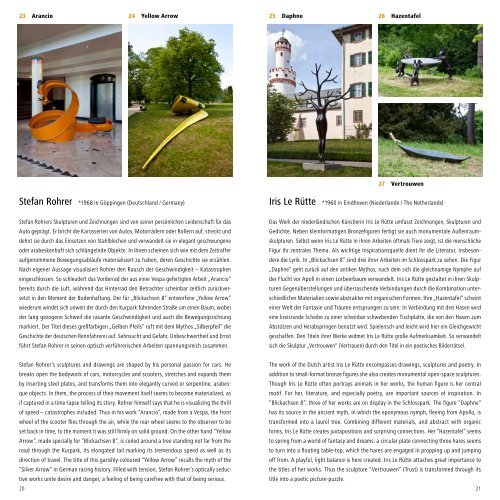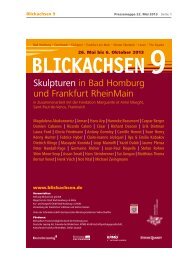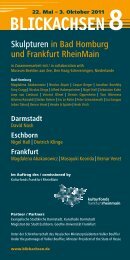Skulpturen in Bad Homburg und Frankfurt RheinMain - Blickachsen
Skulpturen in Bad Homburg und Frankfurt RheinMain - Blickachsen
Skulpturen in Bad Homburg und Frankfurt RheinMain - Blickachsen
Erfolgreiche ePaper selbst erstellen
Machen Sie aus Ihren PDF Publikationen ein blätterbares Flipbook mit unserer einzigartigen Google optimierten e-Paper Software.
9 Early Forms 10 Wild Relatives<br />
Tony Cragg *1949 <strong>in</strong> Liverpool (Großbritannien / UK)<br />
Tony Cragg zählt zu den bedeutendsten Bildhauern der Gegenwart <strong>und</strong> wurde vielfach aus-<br />
gezeichnet. Zuletzt wurde Cragg, der Rektor der Düsseldorfer Kunstakademie ist, 2007 der<br />
Praemium Imperiale des japanischen Kaiserhauses verliehen, der als ‚Nobelpreis der Künste‘<br />
gilt. E<strong>in</strong> <strong>in</strong>tensives <strong>und</strong> dynamisches Zusammenspiel von Material, Farbe <strong>und</strong> Form kenn-<br />
zeichnet se<strong>in</strong>e raumgreifenden ungegenständlichen <strong>Skulpturen</strong>. E<strong>in</strong>e Arbeit wie „Early<br />
Forms“ mit ihren Drehungen, W<strong>in</strong>dungen, E<strong>in</strong>stülpungen <strong>und</strong> Hohlräumen wirkt wie e<strong>in</strong> <strong>in</strong><br />
e<strong>in</strong>em Entwicklungs- <strong>und</strong> Bewegungsprozess sich bef<strong>in</strong>dliches biomorphes Gebilde, das die<br />
Natur noch nicht ganz vollendet hat – <strong>und</strong> er<strong>in</strong>nert doch auch an von Menschenhand<br />
gemachte Werkstücke. Tony Craggs dynamische Skulptur „Wild Relatives“ entwickelt sich<br />
aus der seriellen Wiederholung e<strong>in</strong>es menschlichen Kopfes, der vielfach verzerrt ist <strong>und</strong> sich<br />
sche<strong>in</strong>bar <strong>in</strong> e<strong>in</strong>er kreisenden Bewegung im Raum entwickelt <strong>und</strong> manifestiert. Zentrale<br />
Gestaltungselemente der organisch <strong>und</strong> zugleich künstlich anmutenden Werke von Tony<br />
Cragg s<strong>in</strong>d Bewegung, Wandel <strong>und</strong> Prozesshaftes. So s<strong>in</strong>d se<strong>in</strong>e <strong>Skulpturen</strong> trotz ihrer Unge-<br />
genständlichkeit als Bilder des Lebens zu deuten.<br />
Tony Cragg is one of the most important contemporary sculptors and has received numerous<br />
<strong>in</strong>ternational awards. Most recently Cragg, who is the director of the Düsseldorfer Kunstakademie,<br />
was awarded the 2007 Praemium Imperiale of the Japanese imperial household, considered<br />
to be the ‘Nobel prize of the Arts’. His spatially extensive, non-representational sculptures<br />
are dist<strong>in</strong>guished by an <strong>in</strong>tensive and dynamic <strong>in</strong>terplay of material, colour and form. A work<br />
such as “Early Forms”, with its twists and turns, compressions and hollows, seems like an<br />
object that is cont<strong>in</strong>uously develop<strong>in</strong>g and mov<strong>in</strong>g, a biomorphic construct that nature has<br />
not yet completed – but recall<strong>in</strong>g nonetheless a workpiece made by man. Tony Cragg’s<br />
dynamic sculpture “Wild Relatives” is developed from the serial repetition of a human head<br />
that has been multiply distorted and seems to be develop<strong>in</strong>g and manifest<strong>in</strong>g itself through<br />
a circular movement <strong>in</strong> space. The central creative elements of the organic and at the same<br />
time artificial-seem<strong>in</strong>g works of Tony Cragg are movement, change and process. This is why<br />
his sculptures, despite be<strong>in</strong>g non-representational, can be read as images of life.<br />
11 Delfter Kab<strong>in</strong>ett<br />
Nicolas D<strong>in</strong>gs *1953 <strong>in</strong> Tegelen (Niederlande / The Netherlands)<br />
Das Œuvre des niederländischen Künstlers Nicolas D<strong>in</strong>gs wird bestimmt durch se<strong>in</strong>e Fasz<strong>in</strong>a-<br />
tion für die Grenzbereiche von Kunst, Kunsthandwerk <strong>und</strong> Volkskunst mit ihren unterschied-<br />
lichen Ästhetiken <strong>und</strong> Funktionen. D<strong>in</strong>gs arbeitet mit den verschiedensten Materialien, die<br />
er auch als Bedeutungsträger <strong>in</strong> se<strong>in</strong>e Arbeiten <strong>in</strong>tegriert. Er entlehnt die Motive se<strong>in</strong>er Werke<br />
häufig der Bildersprache der Renaissance <strong>und</strong> se<strong>in</strong>e figürlichen Plastiken bieten e<strong>in</strong> breites<br />
Spektrum von Assoziationsmöglichkeiten. Für „<strong>Blickachsen</strong> 8“ hat er e<strong>in</strong> „Delfter Kab<strong>in</strong>ett“<br />
entworfen <strong>und</strong> vor dem H<strong>in</strong>tergr<strong>und</strong> des <strong>Bad</strong> <strong>Homburg</strong>er Schlosses platziert. Die <strong>in</strong> e<strong>in</strong>em<br />
Schaukasten ausgestellten Objekte s<strong>in</strong>d im Stil der berühmten, ab etwa 1600 im holländi-<br />
schen Delft hergestellten blau-weißen Fayencen gefertigt, die ursprünglich <strong>in</strong> Nachahmung<br />
des von Handelsschiffen aus Ch<strong>in</strong>a importierten Porzellans entstanden. Vor dem historischen<br />
Bezugsrahmen der toleranten Vere<strong>in</strong>igten Niederlande des 16./17. Jhdts. <strong>und</strong> ihres ausge-<br />
prägten Welthandels, beschreibt D<strong>in</strong>gs se<strong>in</strong>e Keramiken, die e<strong>in</strong>e Vielfalt von aktuellen poli-<br />
tischen Motiven <strong>und</strong> Porträts tragen, als „multikulturelle Mischung aus Ordnung <strong>und</strong> Chaos“,<br />
mit der er gesellschaftsrelevante Fragen nach Identität <strong>und</strong> kultureller Vielfalt aufwirft.<br />
The work of the Dutch artist Nicolas D<strong>in</strong>gs is determ<strong>in</strong>ed by his fasc<strong>in</strong>ation for the borderl<strong>in</strong>es<br />
of art, handicraft and folk art, with their differ<strong>in</strong>g aesthetics and functions. D<strong>in</strong>gs works<br />
with the most varied materials, which he also <strong>in</strong>tegrates as a carrier of mean<strong>in</strong>g <strong>in</strong>to his<br />
works. His motifs are frequently derived from the pictorial language of the Renaissance, and<br />
his representational work offers a wide range of associative possibilities. For “<strong>Blickachsen</strong> 8”<br />
he designed a “Delft cab<strong>in</strong>et”, placed aga<strong>in</strong>st the backgro<strong>und</strong> of the <strong>Bad</strong> <strong>Homburg</strong> castle.<br />
The objects displayed <strong>in</strong> the cab<strong>in</strong>et are <strong>in</strong> the style of the renowned blue and white porcela<strong>in</strong><br />
manufactured <strong>in</strong> Delft <strong>in</strong> Holland from aro<strong>und</strong> 1600, itself an imitation of the porcela<strong>in</strong><br />
brought from Ch<strong>in</strong>a by merchant ships. Aga<strong>in</strong>st the historical framework of a tolerant United<br />
Netherlands of the 16th and 17th centuries, with her developed global trade, D<strong>in</strong>gs describes<br />
his ceramics, with their contemporary political motifs and portraits, as “a multi-cultural<br />
mixture of order and chaos”, by means of which he raises questions about identity and<br />
cultural diversity <strong>in</strong> modern society.<br />
10 11






